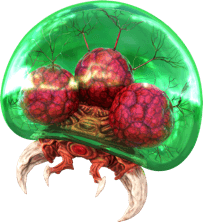Larva Metroid (5e Creature)
Larva Metroid[edit]
|
Medium aberration (metroid), unaligned Armor Class 16 (natural armor)
Saving Throws Dex +5, Con +6 Freezing Vulnerability. The metroid’s gelatinous body is particularly vulnerable to cold temperatures. Whenever the metroid takes cold damage, it must make a DC 15 Constitution saving throw; on a failed save, its flying speed is halved and it gains disadvantage on all attack rolls and saving throws until the end of its next turn. Grappler. The metroid has advantage on attack rolls against any creature grappled by it. Magic Weapons. The metroid's weapon attacks are magical. ACTIONSBite. Melee Weapon Attack: +6 to hit, reach 5 ft., one target. Hit: 11 (2d8 + 2) piercing damage, and the target is grappled (escape DC 14). Until the grapple ends, the target is restrained and must make a DC 15 Constitution saving throw at the end of each of its turns, taking 21 (6d6) necrotic damage on a failed save, or half as much damage on a successful one. On a failed save, the target's hit point maximum is reduced by an amount equal to the damage taken. This reduction lasts until the target finishes a long rest. A creature dies if its hit point maximum is reduced to 0.
|
A metroid is a bizarre and deadly organism known for its ability to leech the life energy from other creatures. It latches onto its victims with powerful fangs and sucks them dry, leaving behind a brittle, desiccated husk that crumbles at the slightest touch. Floating Horror. A metroid is a roughly spherical creature, with most of its body consisting of a gelatinous membrane. Three nuclei are visible within this membrane, connecting to a circular mouth filled with small teeth. Surrounding this mouth are four large fangs, which the Metroid uses to grab onto its prey. It is able to hover and fly through unknown means. Artificial Origins. Though no one is certain where metroids come from, several rumours and legends claim that the creatures were brought into existence by an ancient race of mystics. Who these mystics were, and why they created the Metroids, has been the subject of much debate. Some believe that the creatures were bred to be guardians, others that they were conceived as weapons of war that turned against their makers. Whatever their origins, it is clear that metroids pose a great danger to anything around them. Subterranean Parasites. Metroids typically dwell underground in dank fetid caverns, where they prey upon troglodytes, grimlocks, deep gnomes, and anything else that they can sink their fangs into. They avoid areas of extreme cold, for their gelatinous bodies freeze in low temperatures. Because of this, most denizens of the Underdark that live near a Metroid’s territory tend to learn cold-based magic for self-defence. Evolving Evil. Metroids follow a complicated life cycle wherein they moult into larger, more complex forms as they grow older. This form, known as the larva metroid, is the initial stage of the metroid life cycle. |
Back to Main Page → 5e Homebrew → Creatures



